I remember being shocked (and more than a little frustrated) when I realized my fifth graders couldn’t restate questions in complete sentences… even simple questions. On the spot, I had to pivot my lesson. If your students struggle with restating questions, this post will share the tips and strategies I have learned and put in place that helped my students.

Tip #1: Start With Easy Questions for Students to Restate
When I first discovered that my students were not able to restate the question when answering questions about a text or a read aloud, I backed it all the way back up to modeling, teaching, and having them practice answering extremely easy questions that they immediately knew the answer to.
Questions like:
- What toppings do you like on your pizza?
- What is your favorite subject in school?
- What was the last TV show you watched?
- What is your favorite song?
By making it super easy for students and giving them questions that they could easily answer, I was reducing the cognitive demand and allowing them to focus on the process of restating the question.
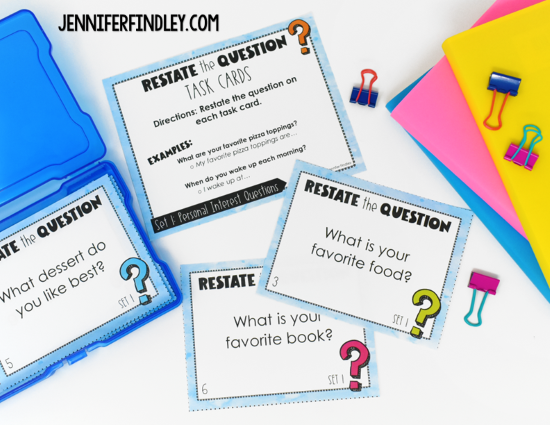
Tip #2: Explicitly Teach and Model Restating the Question (and with a Variety of Types)
My next tip is to explicitly teach and model how to restate questions. Start with the same easy questions to explicitly teach students how to restate the question.
One acronym that a lot of teachers use is PQA, which is an acronym that stands for Put the Question in the Answer. The acronym is a nice reminder, but we also need to model and explicitly teach students how to do this.
Here are some example steps you can use with your students:
- Identify what the question is asking. (Hint: Look for who, what, when, where, why, or how.)
- Determine the keywords or phrases in the question.
- Find the correct answer to the question.
- Use the keywords and the answer to form a new sentence that answers the question.
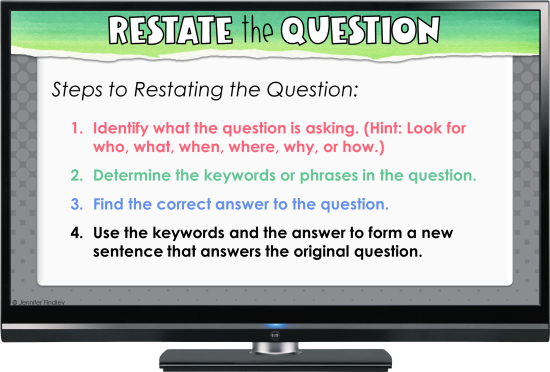
In order for this to be effective, you will need to model this for students.
💡Present questions and model each step. Show them how to find what the question is asking, how to identify if a keyword or phrase is important to use in the restatement, and how to use those keywords or phrases to form a complete sentence.
💡Use a variety of different types of questions where the answer and the question words are in different places in the answer. For example, the answer may be at the end, in the middle, or at the beginning. You can even show students how one question could be answered with the answer in different places.
💡Another important thing to make sure that you’re teaching students is why restating questions is important for them to do. Here are some reasons you can use with your students:
- It helps students stay on track when writing their answers. If they’re not able to restate the question, then they can’t be positive that they know what the question is even asking them. Restating the question will help them make sure they know what they’re answering.
- It gives the reader context. It’s important for teachers and others that read students’ answers to be able to understand what they are trying to say.
- Restating questions also helps build writing skills, increase vocabulary, and practice spelling.
💡Here are some other tips to teach/model/remind your students when teaching them how to restate questions:
- Do not start answers with pronouns. When they are first answering a question about a character or a person, they need to use the specific person’s name in the beginning. This will let the reader know exactly who is being talking about
- Make sure students answer all parts of the question. Some questions have multiple parts and students need to make sure that they’re answering all parts.
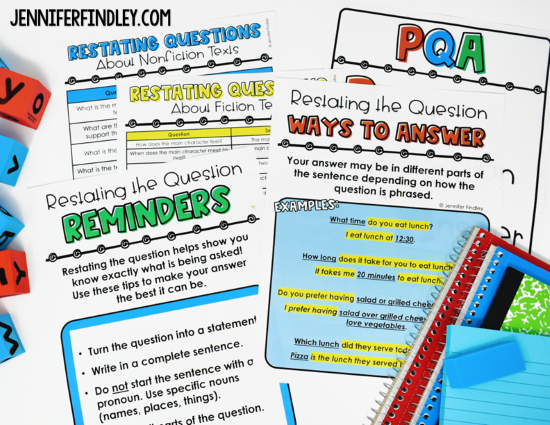
Tip #3: Provide Students with Restatement Stems
While students are still learning to be proficient with restating questions, you may want to provide sentence stems as a scaffold.
When your students are answering a question, write the sentence stem underneath that question to help them get started. Have students write that first part of the restatement and then finish it with the answer.
Example: What is the main idea of the text? The main idea of the text is…. OR …is the main idea of the text.
This is providing a scaffold, but it’s also still modeling and showing different ways that questions can be restated.
This strategy is also a great scaffold when doing partner talks about a read aloud or small group text.
You can ask the students, “How was the main character feeling in this part of the story? Turn and tell your partner how the main character was feeling. Use this sentence stem. The main character was feeling _____because____.”
The blanks are where the students would answer. You can do this orally or write it on the board for students if they need that.

Tip #4: Have Students Answer Questions Verbally with Complete Sentences
Another tip is to have the students use complete sentences when they are answering questions verbally. This is important because if students can’t speak in complete sentences and answer questions verbally by restating the question, it’s going to be more difficult for them to do that in writing.
Ask a question for students to answer out loud (with you or with partners). You can post on the board or say a sentence stem for them to use. You can provide that stem if needed and then slowly take it away as students become more proficient with restating questions.
Tip #5: Get Creative and Engaging with Restating the Question Practice
Get creative and engaging with the practice you give students. Don’t just have this be a chore where the students are restating question after question or just answering packets of questions about texts.
Here are some different ways you can have students practice restating questions that are a bit more engaging (and every little bit of engagement counts!):
Hands-On Puzzles
You can use puzzles where the students match the question with the correct restatement.
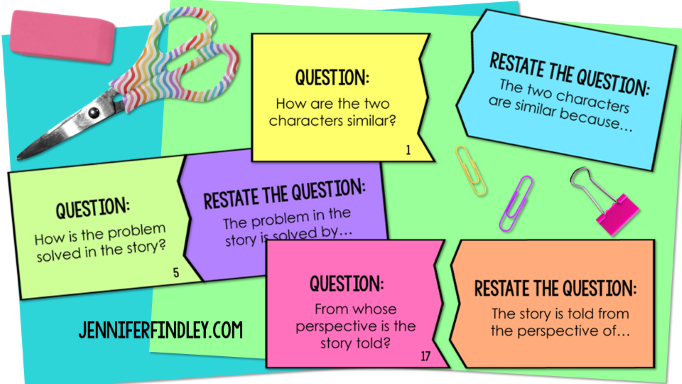
SCOOT Task Card Activity
You can use task cards with a SCOOT activity where the students scoot from desk to desk ad practice restating the question (not answering the question but just restating it.)
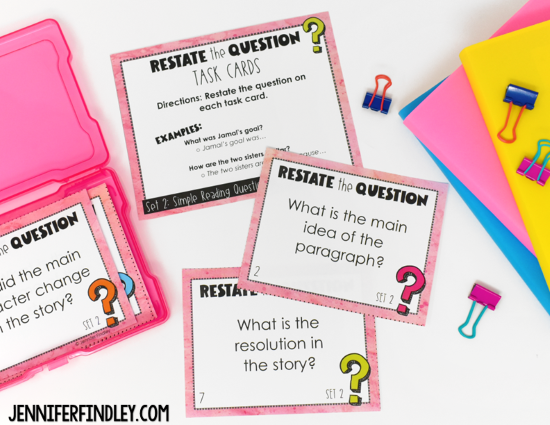
Around the Room Activity with Restate the Question Task Cards
You could take the same type of task cards used in SCOOT and tape them around the room to create an “Around the Room” activity. This will have the students getting up and going from place to place by themselves or with partners to restate questions shown on task cards.
Click here to read more about this type of activity.
Play Bingo
You can also play bingo in small group or whole group. You present the students with a question and they have to find the correct restatement on their bingo board.
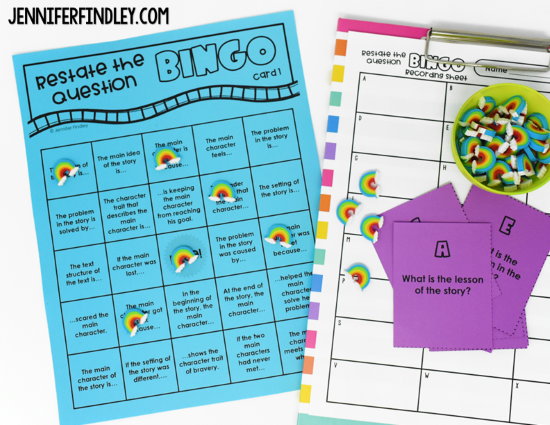
Use Novel Supplies or Writing Tools
Another easy way to add engagement to restating the question of practice is to have the students use novel supplies to practice. Anything that you can add that is a bit more fun will increase their engagement and have them eager to practice this skill.
Examples include:
- marker boards
- colored pencils
- smelly markers
- using construction paper or mini anchor charts to restate questions
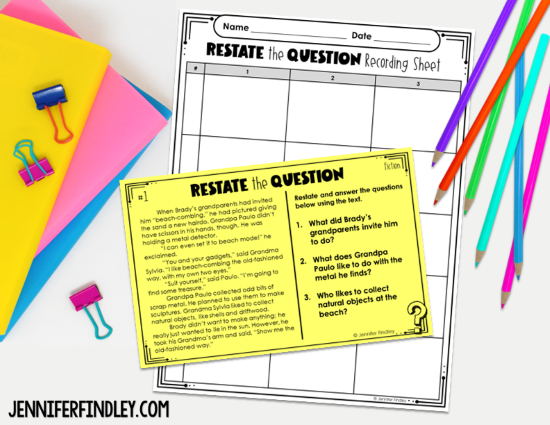
Rapid-Fire Choral Response
When you have free moments in the day, you can do a rapid-fire activity where you ask several questions and have students restate them with no expectation that they’re answering it. This can be used for review or even a warmup.
To do this, just ask a question and have students do a choral response of restating that question and answer. You could also have them restate the question with a partner first or they may even write the question on their marker board and leaving a blank for the answer.
Tip #6: Reinforce All Year (Supporting as Needed)
Finally, you want to make sure that you are reminding the students throughout the year to restate questions that they answer. A super simple way to do this is to use an acronym when students are answering short answer questions such as RACE.
To read more information about RACE and more details, click here.
Get the FREE Restate the Question Presentation & Printables Here!
For access to this FREE constructed response collection, click on the image below. You will be taken to a webpage where you can enter your email to unlock access to the resources. The collection includes the freebie shown in this blog post, along with other resources for teaching and practicing constructed responses in 4th and 5th grade.
Need More Restate the Question Activities?
If you are wanting more activities and resources to help your students practice restating questions, check out these from my TPT store. The task cards are perfect for SCOOT, around the room, or even a reading center. The Bingo is perfect for whole group or small group practice.
Need RACE Practice and Activities?
Shop This Post

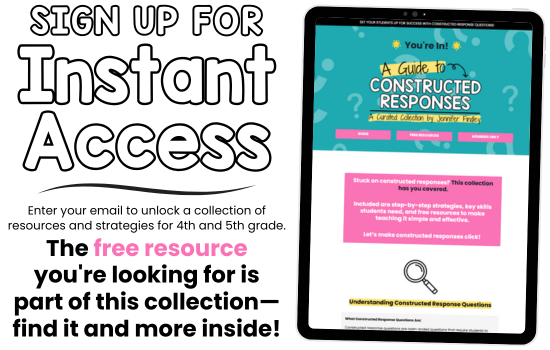
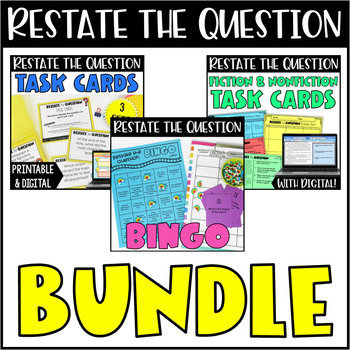
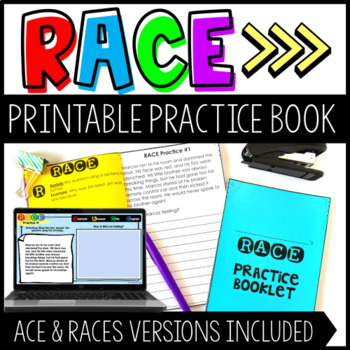








Are the posters for Restating the Question still free? When I click on it, there is not a link to them. Thank you.
Hi Julie, enter your email in the section titled: Get the FREE Restate the Question Presentation & Printables Here! to get the free posters and presentation.
Do you still have the PowerPoint presentation?
Hi Brenda, enter your email in the section titled: Get the FREE Restate the Question Presentation & Printables Here! to get the free presentation.
I cannot find the restate the question puzzles. Are they still free? Thanks!
Hi Amy, did you enter your email in the section titled: Get the FREE Restate the Question Presentation & Printables Here!?
There is no link to the restate the question puzzles. I entered my email but the only thing included was the presentation. Thanks.
Hi Dawn, the puzzles start on page 15 of the PDF. 🙂